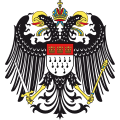Cologne
Cologne (German: [Köln] Error: {{Lang}}: text has italic markup (help), Kölsch: Kölle) is a city in the state of North Rhine-Westphalia in Germany. It is on the Rhine River. About 1,060,000 people live there, making Cologne the biggest city in North Rhine-Westphalia. It is in the southern part of the 'Rhine-Ruhr agglomeration' of cities with a combined total population of about 10 million people. This is one of the most densely populated areas of the world.
 | |
| Coordinates: 50°56′11″N 6°57′10″E / 50.93639°N 6.95278°ECoordinates: 50°56′11″N 6°57′10″E / 50.93639°N 6.95278°E | |
| Country | Germany |
| State | North Rhine-Westphalia |
| Admin. region | Cologne |
| District | Urban districts of Germany |
| Founded | 38 BC |
| Government | |
| • Lord mayor | Henriette Reker |
| Area | |
| • City | 405.15 km2 (156.43 sq mi) |
| Elevation | 37 m (121 ft) |
| Population (2014/12/31) | |
| • Metro | 3,573,500 |
| Time zone | UTC+01:00 (CET) |
| • Summer (DST) | UTC+02:00 (CEST) |
| Postal codes | 50441–51149 |
| Vehicle registration | K |
| Website | www |
Cologne has an oceanic climate (Cfb in the Koeppen climate classification).
History
The city was founded by the Romans in the year 50 AD. Before that, it was a Roman castle ("castellum") and a town inhabited by a local German tribe named Ubier at least for 100 years. Archaeologists have found out that the surrounding area was populated already during the Stone Age.
Traditionally, the city was always Roman Catholic. That changed only recently after the Second World War, as a result of massive immigration of Protestants from the East of Germany. Still the largest number of people, 41.6%, are Roman Catholic, compared to 17% Protestant. 10% of the people are Muslim.
Sights
The most interesting thing to see there is Cologne Cathedral. This church was built from about 1248 to about 1550, but completed only in 1880. The United Nations list it as 'World Cultural Heritage'. Cologne's archbishop Rainald von Dassel brought the relics of the biblical Three Wise Men there in 1164. They are kept in a very beautiful golden shrine in the cathedral. Three golden crowns in the coat of arms of the city symbolize them. They made Cologne a major place of pilgrimage.
The University of Cologne alone has more than 50,000 students. It was founded 1919 and is one of the biggest universities in Germany. There are several specialized Schools in addition to the university. The Hochschule für Musik is the biggest academy of music in Europe. Cologne has two colleges of arts and the sports college again is one of the biggest institutions of its kind worldwide.
Cologne has 31 museums. It has one of the busiest train stations in Europe. It is the only train station next to a big cathedral.
Culture
People in Cologne and nearby have their own dialect. They call it Kölsch. During Carnival time it even appears on nationwide broadcasts.
Cologne has a handful of broadcasting stations. The Westdeutscher Rundfunk, part of the network ARD, is the biggest producer of television and radio programs in Germany.
Cologne is also famous for Eau de Cologne (Kölnisch Wasser).[1]
Cologne Media
Attack on Deutz by the Swedish army during the Thirty Years' War in 1632
Reconstruction of Cologne in the 17th century (German, English subtitles available)
Related pages
- Berlin
- Bonn (nearby city)
- Düsseldorf (nearby city)
- Frankfurt/Main
- Hamburg
- Leverkusen (nearby city)
- Munich
References
- ↑ "Eau de Cologne". Archived from the original on 2008-11-23. Retrieved 2009-03-03.
Other websites
![]() Media related to Cologne at Wikimedia Commons
Media related to Cologne at Wikimedia Commons










